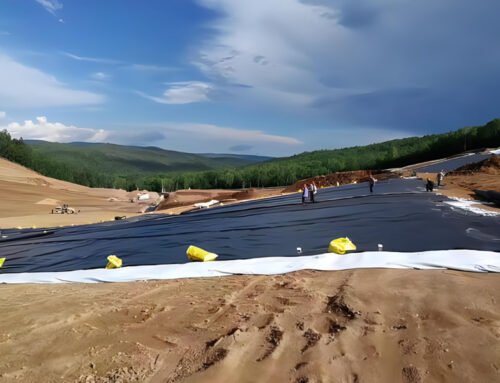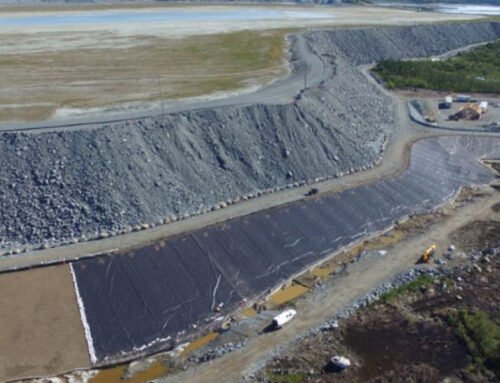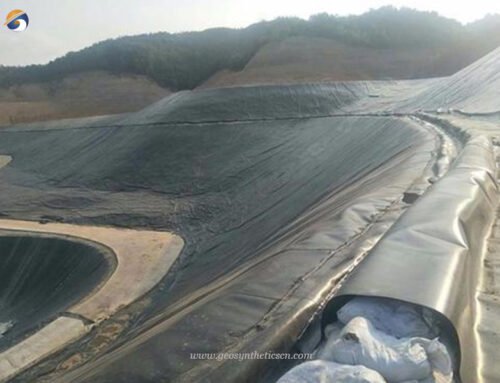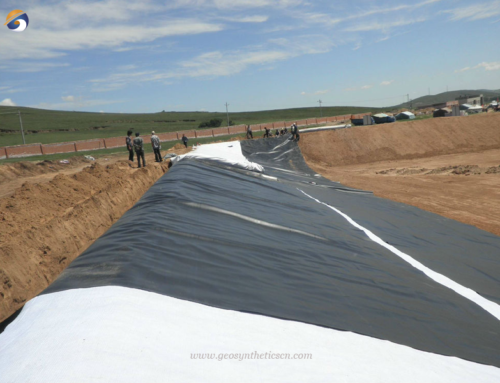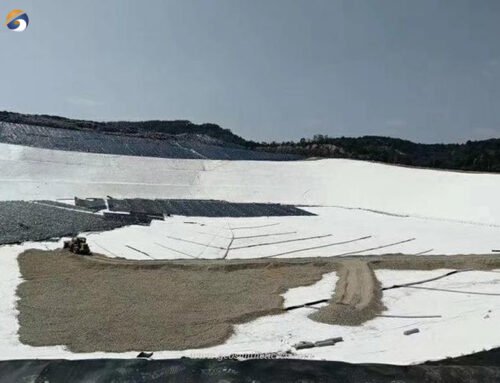HDPE landfill geomembrane is the low permeable synthetic membrane and geotechnical engineering materials which are widely used for solid waste containment, mining and water containment applications.
As the leading geomembrane manufacturer and supplier, GEOSINCERE offers custom geomembrane liner with varius size and thickness at best factory price.
1. What Is Landfill Geomembrane?
HDPE geomembrane liner is made of finest quality high density polyethylene (HDPE) with specially formulated, virgin polyethylene resin, combined with specified quantity carbon black, antioxidant, anti-aging agent and UV resistance components, which makes our smooth geomembrane HDPE liner with excellent resistance to UV radiation and is suitable for exposed conditions.
GEOSINCERE HDPE landfill geomembrane liner is produced using state-of-the-art automatic geomembrane production lines and advanced three-layered pressing technology, adhering to the GRI GM13 standard. In comparison to traditional concrete, asphalt, and compacted clay, our HDPE landfill geomembrane liner offers significant advantages in terms of cost-effectiveness, environmental safety, durability, chemical resistance, rapid deployment, and easy transportation.
We have successfully supplied various types of effective and cutting-edge geomembranes and other geosynthetics to more than 36 countries worldwide. Our satisfied customers come from diverse regions such as Australia, France, Sweden, the UK, Hong Kong, Hungary, New Zealand, Poland, Mexico, Ecuador, Brazil, Pakistan, Bangladesh, Thailand, Vietnam, Malaysia, Indonesia, Singapore, the Philippines, Sri Lanka, India, the UAE, Saudi Arabia, Qatar, Kenya, Ghana, Ethiopia, Somalia, Nigeria, South Africa, Swaziland, Mongolia, and many more.
GEOSINCERE commitment extends beyond manufacturing top-quality geomembrane products; we also provide professional design and installation services. We offer OEM, ODM, custom development, and fabrication options to meet specific project requirements.

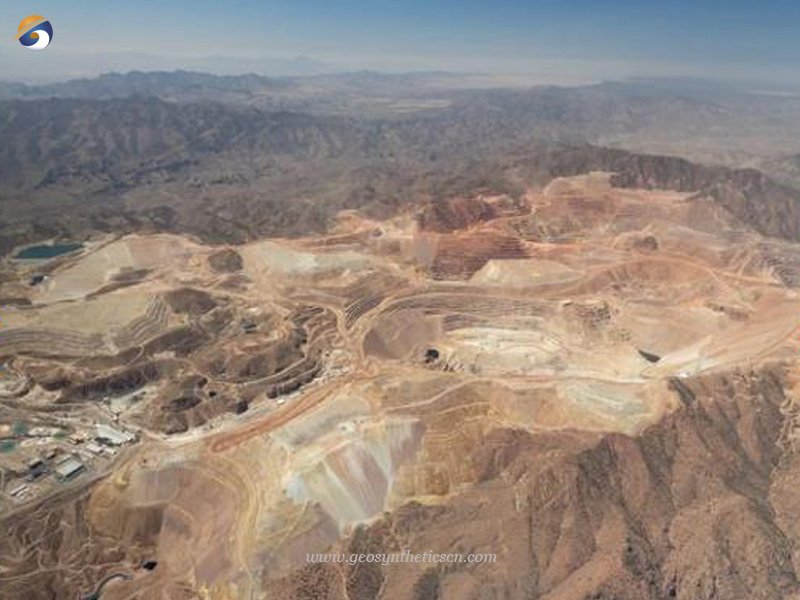
2. HDPE Landfill Geomembrane Solution for Kalahri Mining Project in South Africa
The Kalahari Manganese field is located in the Northern Cape Province, 700km south-west of Johannesburg, South Africa. It contains approximately 80% of the world’s known high-grade manganese ore reserves. The district yields four million tonnes per annum (Mtpa), which is mined mainly by two companies: Samancor and Assmang.
With so many uses for geomembranes in the mining industry, during both active and closed stages of a project, it’s no wonder they’re so widely used. However, not all geomembrane products will work for mining applications. Using the wrong material for a hydraulic fracturing brine pond or a heap leaching pad will only result in failures and costly losses. Making the right choice from the start is easier than you might think. Simply choose a polymer based on their characteristics, decide on reinforced and textured features, and consider how you plan to install the landfill geomembrane liner.
High density polyethylene (HDPE) is widely available, but it’s far more prone to cracking under stress than other types of polyethylene. It offers decent chemical resistance and less UV resistance than RPE. Welds are reasonably strong for reliable seams. Unfortunately, this is balanced out by poor puncture resistance and extensive thermal expansion in applications with hot wastewater. This material isn’t a great choice for use on its own in a mining project.
Polyvinyl chloride (PVC). More flexible than HDPE liners, PVC isn’t very durable and lacks the chemical resistance necessary for mining use. The material resists wrinkling relatively well due to its flexibility, but it’s less durable and offers poor tear resistance in rocky soils. It’s also not entirely UV resistant in most formulations and will break down eventually when installed in an exposed setting. High and low temperatures also damage PVC liners, both of which are possible on the mining site. Skip this material for process and storage ponds.
Low density polyethylene (LDPE). For the combination of chemical resistance and flexibility, LDPE is a relatively good choice. Yet it still has some disadvantages that keep it from being the ideal choice for most mining projects. First, this material is even less UV resistant than HDPE geomembrane. It’s also less chemical resistant. While the softer material is less likely to wrinkle than stiffer membranes, especially when reinforced, it’s not as durable as you need for mining purposes. Rough ores and sediments will quickly wear out a liner made of LDPE alone. LDPE is not an ideal liner when used alone, but it may work well in combination with other geomembranes.
The mining industry recommends the use of reinforced geomembranes. These liners provide a better lay-flat experience and reduce the number of wrinkles that form during installation. Unremoved wrinkles slowly compress over time due to the weight of water and sediment. Ores processed in ponds are particularly heavy and tend to stretch non-reinforced lining products. Especially reinforced polyethylene (RPE) is designed to resist stretching and expansion under heavy loads. These linings are also more resistant to freeze damage from colder climates, making them ideal for mines located in both high and low latitudes of the world.
- Total HDPE Landfill Geomembrane Require Quantity – 70,560 square meters
- Geomembrane thickness – 1.5 mm
- Each roll size – 7m×140m
- Four 40 HQ containers
At the beginning the Assmang company visited us, we have 26,000 square meters factory and advanced production line of geomembrane and geotextile gave them professional impression . before we sign agreement they need we offer product brochure , ISO Certificate , SIRIM Certificate ,Test Certificate ,Project References and material safety date sheet , all they requirement we can offer to them .after we signed the order and accept the deposit , consider project time schedule , we speed up the time supply of 40hq*3 container within 14days to catch up for required deadline .
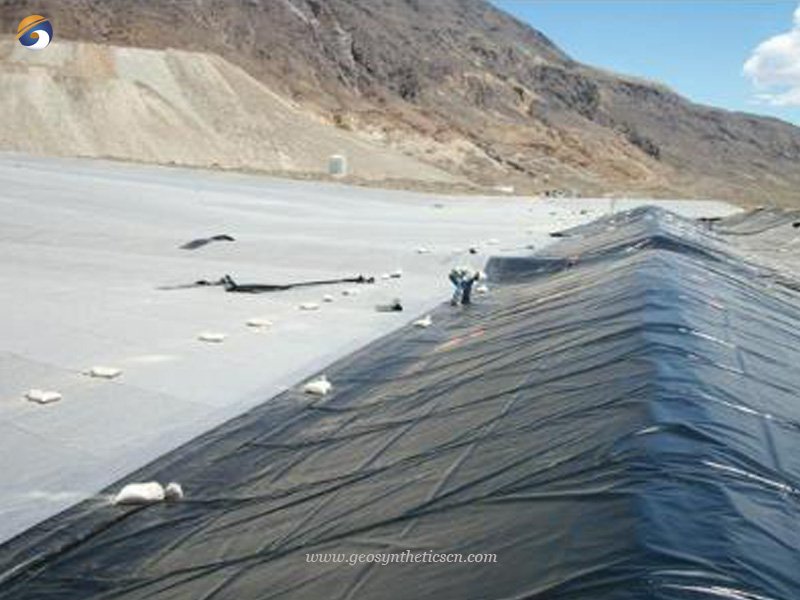

3. What Are Advantages of HDPE Landfill Geomembrane?
The HDPE landfill geomembrane liner possesses a range of notable features that contribute to its exceptional performance:
3.1 Excellent chemical resistance
The liner exhibits remarkable resistance to various chemicals, ensuring its longevity and integrity in challenging environments.
3.2 Outstanding stress crack capacity
The liner’s robust design enables it to withstand stress cracking, even under demanding conditions, maintaining its structural integrity.
3.3 Lowest permeability
With an extremely low permeability rate, the geomembrane liner effectively prevents the migration of liquids and gases, enhancing containment efficiency.
3.4 Excellent UV resistance
The liner is specifically engineered to withstand prolonged exposure to UV radiation, ensuring its durability and longevity in outdoor applications.
3.5 Stable low-temperature embrittlement resistance
The geomembrane liner maintains its flexibility and performance, even in cold climates, with exceptional resistance to low-temperature embrittlement.
3.6 Complete width and thickness specifications
The liner is available in a wide range of width and thickness options, allowing for customization to meet specific project requirements.
3.7 Cost-effective
Compared to alternative materials, the HDPE landfill geomembrane liner offers a cost-effective solution, providing long-term durability and performance at a competitive price.
3.8 Proven performance
The liner has a track record of reliable performance in various applications, demonstrating its effectiveness and suitability for landfill projects.
3.9 Fast deployment
The design of landfill geomembrane enables efficient and rapid installation, reducing project timeframes and associated costs.
All GEOSINCERE HDPE landfill geomembrane liner meets or exceeds all aspects of the GRI GM13 standard, ensuring compliance with industry guidelines and regulations.
4. What Are Landfill Geomembrane Used For?
Smooth HDPE geomembrane liners find extensive applications in various industries and sectors:
4.1 Canal, Aquaculture, and Irrigation Ponds
Smooth geomembrane liners are commonly used for lining canals, aquaculture facilities such as fish ponds and shrimp ponds, and irrigation ponds to prevent seepage and ensure water containment.
4.2 Landfills
They are employed as bottom liners, landfill sealing covers, and leachate regulating pool liners, providing effective containment of waste materials and preventing contamination of the surrounding environment.
4.3 Water Treatment Systems
Smooth geomembrane liners play a crucial role in power plant and sewage treatment pools or water treatment systems, helping to regulate and control the flow of water and prevent seepage.
4.4 Mining
HDPE geomembrane liners are utilized in the mining industry for various applications, including washing pools, heap leaching pools, heap yards, dissolving tanks, storage tanks, and as bottom liners for tailing seepage control. They help prevent the seepage of harmful substances and protect the environment.
4.4 Other Applications
Smooth geomembrane liners have a wide range of applications in environmental protection and sanitation projects, water conservancy projects, municipal infrastructure projects, landscaping initiatives, petrochemical industry facilities, salt industry facilities, agriculture, and more.
HDPE landfill geomembranes are favored in diverse industries where effective containment, seepage control, and environmental protection are essential.
5. About GEOSINCERE
GEOSINCERE has been dedicated to manufacturing wholesaling geotexitle and geosynthetics products and solutions to worldwide customers since its foundation in 2007. Our main innovative, high quality products include geotextiles, geomembranes, geogrids, geocells, geosynthetic clay liners, and drainage boards, etc al.
GEOSINCERE offers both high quality geosynthetic products but also professional design and installation service. OEM, ODM, custom development and fabrication are also available. If you have any questions or inquiries, please contact us, we will reply as soon as possible.

